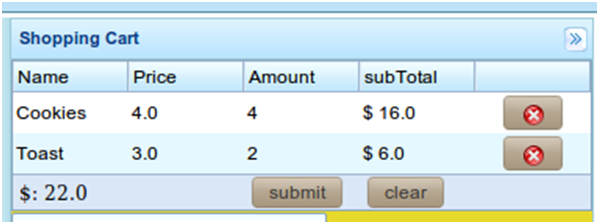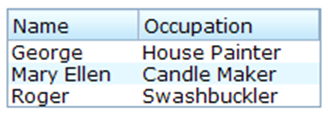Implementing the View"
Tmillsclare (talk | contribs) m (Created page with '===Implementing the View=== Suppose the figure below is the requirement for the "Shopping cart" in our shopping cart application: File:ZKEss_shopping_cart.png Here we hav…') |
|||
| (14 intermediate revisions by 3 users not shown) | |||
| Line 1: | Line 1: | ||
| + | {{ZKEssentialsPageHeader}} | ||
| + | |||
===Implementing the View=== | ===Implementing the View=== | ||
| − | Suppose the figure below is the requirement for the "Shopping | + | Suppose the figure below is the requirement for the "Shopping Cart" in our shopping cart application: |
[[File:ZKEss_shopping_cart.png]] | [[File:ZKEss_shopping_cart.png]] | ||
| − | Here we have five columns, four | + | Here we have five columns, four of them have headers to denote the data field, and a variable number of rows containing product orders. In this case, we also have a requirement to display a picture of the product selected in the shopping cart. In this case, we use the Listbox as this enables developers to select an item firing an onSelect event when this occurs. |
===Introduction to the ZK Listbox=== | ===Introduction to the ZK Listbox=== | ||
| Line 13: | Line 15: | ||
====A Simple Listbox example==== | ====A Simple Listbox example==== | ||
| − | The simplest <javadoc>org.zkoss.zul.Listbox</javadoc> can be outputted using Listitems. In the example below we place 3 Listitems into the <javadoc>org.zkoss.zul.Listbox</javadoc>. | + | The simplest <javadoc>org.zkoss.zul.Listbox</javadoc> can be outputted using Listitems. In the example below, we place 3 Listitems into the <javadoc>org.zkoss.zul.Listbox</javadoc>. |
<source lang="xml"> | <source lang="xml"> | ||
| Line 25: | Line 27: | ||
</source> | </source> | ||
| + | [[File:ZKEss_list.png]] | ||
====The Select Mold==== | ====The Select Mold==== | ||
| − | In addition the <javadoc>org.zkoss.zul.Listbox</javadoc> comes in two molds, default and select. The select mold enables the HTML SELECT tag to be generated | + | In addition to the <javadoc>org.zkoss.zul.Listbox</javadoc> which comes in two molds, default and select. The select mold enables the HTML SELECT tag to be generated thus producing the following content. The following example demonstrates the effect of changing the mold on the <javadoc>org.zkoss.zul.Listbox</javadoc>. |
<source lang="xml"> | <source lang="xml"> | ||
| Line 40: | Line 43: | ||
</source> | </source> | ||
| − | + | [[File:ZKEss_select.png]] | |
| + | |||
====Multiple Columns and Headers==== | ====Multiple Columns and Headers==== | ||
| − | The <javadoc>org.zkoss.zul.Listbox</javadoc> also supports multiple columns and headers. In the following example we use <javadoc>org.zkoss.zul.Listhead</javadoc> and <javadoc>org.zkoss.zul.Listheader</javadoc> to create headers | + | The <javadoc>org.zkoss.zul.Listbox</javadoc> also supports multiple columns and headers. In the following example we use <javadoc>org.zkoss.zul.Listhead</javadoc> and <javadoc>org.zkoss.zul.Listheader</javadoc> to create headers with two columns. The following example demonstrates a multi-column <javadoc>org.zkoss.zul.Listbox</javadoc> with a header. Please note that you can have a multi-column <javadoc>org.zkoss.zul.Listbox</javadoc> without the headers but by specifying more than one <javadoc>org.zkoss.zul.Listcell</javadoc> in a particular <javadoc>org.zkoss.zul.Listitem</javadoc>. |
<source lang="xml"> | <source lang="xml"> | ||
| Line 67: | Line 71: | ||
</zk> | </zk> | ||
</source> | </source> | ||
| − | + | ||
| + | [[File:ZKEss_columns.png]] | ||
====The Shopping cart view Implementation==== | ====The Shopping cart view Implementation==== | ||
| − | The implementation of shopping cart view is placed in the | + | The implementation of the shopping cart view is placed in the right side section of the <javadoc>org.zkoss.zul.Borderlayout</javadoc>. Just like the previous section, the <javadoc>org.zkoss.zul.Listbox</javadoc> is encased by a <javadoc>org.zkoss.zul.Div</javadoc> component which is applied with a controller class to extend the <javadoc>org.zkoss.zk.ui.util.GenericForwardComposer</javadoc> class. We’ll go into details of this controller class in the next section of this book. The only special part of the <javadoc>org.zkoss.zul.Listbox</javadoc> that we haven’t covered is the <javadoc>org.zkoss.zul.Listfooter</javadoc> which is encased in the tag <javadoc>org.zkoss.zul.Listfoot</javadoc>. This will place the specified components on the buttons. In this case, it would be the subtotal with a button to submit an order and a button to clear the order. |
<source lang="xml"> | <source lang="xml"> | ||
| Line 96: | Line 101: | ||
</east> | </east> | ||
</source> | </source> | ||
| + | |||
| + | {{ZKEssentialsPageFooter}} | ||
Latest revision as of 09:10, 19 July 2011
![]() This article is out of date, please refer to http://books.zkoss.org/zkessentials-book/master/ for more up to date information.
This article is out of date, please refer to http://books.zkoss.org/zkessentials-book/master/ for more up to date information.
Implementing the View
Suppose the figure below is the requirement for the "Shopping Cart" in our shopping cart application:
Here we have five columns, four of them have headers to denote the data field, and a variable number of rows containing product orders. In this case, we also have a requirement to display a picture of the product selected in the shopping cart. In this case, we use the Listbox as this enables developers to select an item firing an onSelect event when this occurs.
Introduction to the ZK Listbox
A ZK Listbox contains a few constituents, listitem, listcell, listhead and listheader.
A Simple Listbox example
The simplest Listbox can be outputted using Listitems. In the example below, we place 3 Listitems into the Listbox.
<zk>
<listbox>
<listitem label="Butter Pecan"/>
<listitem label="Chocolate Chip"/>
<listitem label="Raspberry Ripple"/>
</listbox>
</zk>
The Select Mold
In addition to the Listbox which comes in two molds, default and select. The select mold enables the HTML SELECT tag to be generated thus producing the following content. The following example demonstrates the effect of changing the mold on the Listbox.
<zk>
<listbox mold=”select”>
<listitem label="Butter Pecan"/>
<listitem label="Chocolate Chip"/>
<listitem label="Raspberry Ripple"/>
</listbox>
</zk>
Multiple Columns and Headers
The Listbox also supports multiple columns and headers. In the following example we use Listhead and Listheader to create headers with two columns. The following example demonstrates a multi-column Listbox with a header. Please note that you can have a multi-column Listbox without the headers but by specifying more than one Listcell in a particular Listitem.
<zk>
<listbox width="200px">
<listhead>
<listheader label="Name"/>
<listheader label="Occupation"/>
</listhead>
<listitem>
<listcell label="George"/>
<listcell label="House Painter"/>
</listitem>
<listitem>
<listcell label="Mary Ellen"/>
<listcell label="Candle Maker"/>
</listitem>
<listitem>
<listcell label="Roger"/>
<listcell label="Swashbuckler"/>
</listitem>
</listbox>
</zk>
The Shopping cart view Implementation
The implementation of the shopping cart view is placed in the right side section of the Borderlayout. Just like the previous section, the Listbox is encased by a Div component which is applied with a controller class to extend the GenericForwardComposer class. We’ll go into details of this controller class in the next section of this book. The only special part of the Listbox that we haven’t covered is the Listfooter which is encased in the tag Listfoot. This will place the specified components on the buttons. In this case, it would be the subtotal with a button to submit an order and a button to clear the order.
<east title="Shopping Cart" size="30%" flex="true" splittable="true" collapsible="true">
<div style="background:#E6D92C; height:100%" apply="demo.web.ui.ctrl.ShoppingCartViewCtrl">
<listbox id="shoppingCartListbox">
<listhead sizable="true">
<listheader label="Name" />
<listheader label="Price" />
<listheader label="Amount" />
<listheader label="subTotal"/>
<listheader align="center"/>
</listhead>
<listfoot>
<listfooter span="2" id="subtotalFooter"></listfooter>
<listfooter><button id="submitOrderBtn" label="submit"/></listfooter>
<listfooter><button id="clearBtn" label="clear"/></listfooter>
</listfoot>
</listbox>
<textbox id="descTxb" rows="10" width="200px" value="Note for this order." />
<image id="cartItemImage" />
</div>
</east>


